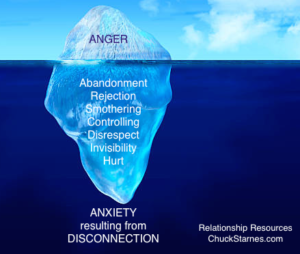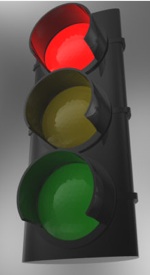‘My husband’s destructive anger is wrecking our family! I can’t deal with his abuse any longer!’
Tears filled Gina’s eyes as she explained what her husband Gary’s anger was doing to her.
This began a 7 step journey that transformed Gary’s destructive anger into passionate love.
Recently, in an argument over how to deal with one of their children, Gary blew up at Gina and put his fist through the wall.
Gary had not previously been physically violent toward Gina or their three children. But there were repeated times of yelling and name-calling.
And now Gary had literally hit the wall. Where was it going to end?
Gina was not only concerned for her own safety, but was really afraid of what this anger would do to their kids.
In our first session, we began a structured dialogue that helped Gary and Gina take seven steps toward dealing with abusive anger.
1. Set a boundary against uncontrolled anger.
It was very important for Gina to say to Gary that uncontrolled anger is not ok. Gina must realize she does not have to tolerate it, and must be empowered to leave the abusive situation in any way necessary. This may include getting a restraining order.
There are cases of emotional and physical abuse where the first step is for the victim to separate from the abusive partner and get professional help.
Gina communicated this boundary in a Dialogue where Gary mirrored and validated her concern.
It was very important that this boundary be communicated to Gary in a safe way. The Couples Dialogue helped him receive and accept it rather than feel judged by it.
In Gary’s case, he was ready to get help, and fully accepted Gina’s boundary.
For Gary and Gina, this act of violence was a wake up call to get help.
Both of them were eagerly seeking change.
They invited me to continue to facilitate this process of transforming anger into passionate love.
2. Commit to “zero negativity”.
After setting a boundary against violence, Gary and Gina agreed to sign the Zero Negativity Challenge.
This is a pledge to stop all negative comments, criticisms, and uncontrolled expressions of anger.
It is something I ask all my clients to sign whether violent anger is an issue or not.
Because nothing can happen in a relationship unless it is safe.
And it will never be safe if the tiniest bit of negativity is allowed in the space between the couple.
Negativity in a relationship is like putting a drop of raw sewage into a glass of pure drinking water.
Would you drink it even if I assured you it contained only a drop of sewage? 🙂
Of course not! Because, even with a drop of bacteria infested sewage, it’s no longer safe to drink.
In the same way, when a drop of criticism or unbridled anger is deposited into the space between a couple, it’s no longer safe to for either partner to open up to each other.
Going forward Gary and Gina weren’t perfect, but this commitment to zero negativity was a good start down the right path.
3. Avoid assigning labels to each other.
“My partner is abusive!”
‘My husband is a narcissist!’
‘My wife has Borderline Personality Disorder!’
Labeling like this produces enough negative energy to keep a person permanently bound in the role assigned to them.
People live up to what we say about them.
It’s important to drop the labels.
And here’s another reason why.
Gary and Gina are just two partners doing the best they can to manage their anxiety.
What do you mean?
When couples feel disconnected, the result is always anxiety.
The human mind cannot handle anxiety for more than a few seconds. To cope we turn it into either anger or depression.
So most people are not what we tend to label them. They’re just trying to manage their anxiety the best they can. Obviously some better than others.
Of course there are true narcissists and there are violent aggressors that are unsafe people period.
But in many cases where a someone claims their partner is a narcissist, it is a label unfairly assigned.
During the Dialogue process, we often find that the “so-called narcissist” is perfectly capable of empathizing with his or her partner. It’s just that the relationship had never been safe enough for that to happen.
We are all self-absorbed until we experience differentiation in our relationship.
It’s the growth challenge of marriage that changes us from self-absorbed individuals into differentiated individuals capable of intimate connection.
In many cases people are self-absorbed because they’ve never stepped up to the ‘growth challenge’ that every marriage presents.
Therefore it’s important not to label.
The Couples Dialogue process helps you reimage your partner as someone who is simply trying to manage their own anxiety the best they can.
Some do it by exploding anger outwardly. Others by internalizing anger and becoming depressed.
4. Listen to anger’s ‘cry for help”.
As Gina mirrored Gary’s angry feelings, she learned that his anger was a cover for deeper emotions he was experiencing.
Usually anger is not about what you say it’s about. It’s a way to protect yourself from your more vulnerable feelings.
Like the tip of an iceberg, anger can be used to cover deeper emotions that we my not be conscious of.
Gina and Gary’s big blow up was not really about differences over child discipline. It was about Gary not feeling important in the process.
And at the very core was Gary’s hidden fear of losing his connection with Gina.
As a child, Gary experienced feelings of abandonment from his early caretakers. Unknowingly, he had brought these wounds into his marriage.
When he felt Gina withdrawing from him, his deep fear of abandonment was triggered.
In an unconscious reaction he would then use anger to mask these feelings of abandonment.
This in turn caused Gina to move even further from Gary.
But Chuck, that doesn’t make sense. If Gary wanted to be connected with Gina, why would he yell and punch the wall?
Why do kids throw temper tantrums?
To get the attention of the parent they fear won’t be available to them when they need it most.
Gary was doing an ‘adult version’ of this kind of behavior.
So how does Gina ‘listen to anger’s cry for help’ and begin to understand Gary’s real emotion behind anger?
It was through the structured Couples Dialogue that Gina felt safe enough to listen and validate Gary.
And in the context of that safety, Gary got in touch with the fear of abandonment that was driving his explosive anger.
And then, as we’ll see later, things went even deeper…
5. Stay present rather than retreating.
As Gina stayed present and listened to Gary, this had a powerful calming effect on him.
It was Gina’s withdrawal that triggered the fear and anger in Gary.
Most every day we walk our dog, Brie, in the neighborhood. There is a cat about a block away that Brie loves to chase. It goes like this.
The cat sees Brie and takes off. When Brie sees the cat take off, she begins pursuit until she reaches the end of her leash. And then it’s all we can do to hold her back. We should have gone to dog training school.
One day the cat saw Brie, and instead of running, he sat down in the driveway and began licking his paw.
Brie was really troubled. And stood perfectly still. Why?
We discovered that Brie will only chase if the cat retreats. If the cat doesn’t run, Brie waits.
In the same way, Gina’s running away was one of the triggers for Gary to pursue her in anger.
A dramatic change occurred when she remained present for Gary. His anger was diffused and he was able to express his fear in a safe dialogue.
Gina was able to empathize with Gary’s feeling of abandonment, and that was when everything changed.
Continuing to be curious in the Dialogue, Gina found out Gary’s hidden fear.
Recently she had became more involved in her work as a school teacher. This meant more social engagement with her coworkers as well.
As Gary saw her having fun with people that had more in common with her than he did, Gary feared that one day she wouldn’t need him and would leave him for good.
So the anger wasn’t about the differences they had in parenting. It was about Gary’s deep fear of being left alone.
Very often the problem you’re arguing about is not the problem. It goes much deeper.
Both Gina and Gary got in touch with the real issue which was Gary’s hidden fear.
This happened because Gina stayed present and curious in the process.
6. Use your anger as a signal to stop and dialogue.
The Couples Dialogue slows things down, enabling you to talk about your anger rather than exploding it.
Anger does not have to be unhealthy. It doesn’t have to turn into destructive aggression.
Anger can be an incredibly useful emotion.
Anger serves as a stoplight – a signal that something is not right and you need to STOP.
Gary learned to recognize when he was angry by noticing the sensations in his body.
Sensations like a tensed body, clenched teeth, restlessness, or increased intensity of speech were the cues that helped him realize he was angry.
If we can recognize anger before it’s expressed, it can be a signal to stop and use our safe conversation skills to talk about it.
If we heed anger’s warning, it’s possible to return to love and connection. If we ignore its warning, our relationship will suffer.
It’s a choice we have to make.
7. Channel anger’s energy into passionate love.
Anger and passionate love are opposite expressions of the same energy.
When anger’s negative energy gets redirected in a safe conversation it transforms into passionate love.
Gary took steps to moderate his anger, by talking it out rather than acting it out.
Gina stretched in order to be present with Gary rather than withdrawing and triggering his feelings of abandonment.
What happened as a result?
Anger was transformed into passionate love.
I saw evidence of this in the parking lot of my office after our last session as Gary and Gina stood by their car for what seemed like forever in a passionate hug and prolonged kiss.
As people watched them, I thought, “They have no idea what’s behind this. If they only knew…”
Gary and Gina not only learned to deal with destructive anger, but all of their feelings of love and passion returned.
That’s because anger’s negative energy can be channeled in the opposite direction. And passionate love can be reborn.
It can happen for you as well. If you need help, I can take you through the same process that Gary and Gina went through. Here’s more info.
If you haven’t already, subscribe below to Relationship Resources and receive my weekly post emailed to your inbox every Saturday morning!





What a great topic that tools to use to diffuse the situation. I appreciate the reminder of the Boundaries, to not allow the anger to continue. It’s so easy to ‘hope ‘ once it ends that it’s the last time.
The illustration about the cup of water with a drop of sewage gives a good idea of even a little contaiminates all of it.
I wasn’t able to finish the entire article at this time but look forward learning more tools soon.
Thank you Linda! Truly we have to have a boundary against abuse as a baseline for a healthy relationship. My concern is for so many couples for whom violence is not an issue but safety IS. It’s my hope that couples can find tools to make their relationship safe so that there can be a connection that unleashes the passionate love they have for each other. I alway appreciate your insights! (And I will try to make the posts shorter in the future…for your sake but for everyone else too!)
Great article Chuck. Anger seems to be a habit we get in to and making the CHOICE to change it sure seems like a lot of work. I’m going to share this with my Chuck and hope it is a revelation to him as well. New year, new effort, RENEWED relationships.
❤️❤️
Thank you Kelli. Anger is an emotion that occurs when anxiety is triggered. Anxiety results when we feel disconnected. Disconnection can occur when we discover our partner is “different” from us. Learning to recognize when I’m angry and NOT let it be come a negative expression will help. I’m learning to find the desire behind my frustration and communicate it to Sandy in a healthy and productive way. The Imago Dialogue is a tool that helps me do that. I don’t always succeed but I’m growing in it. Contact me for a free session and I’ll walk you and your Chuck through it.